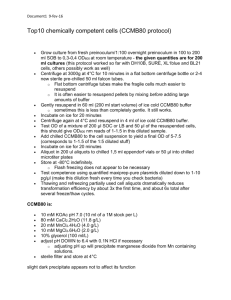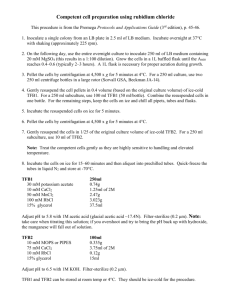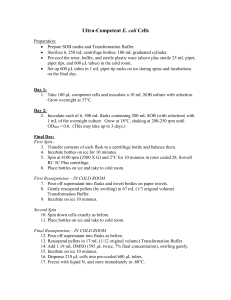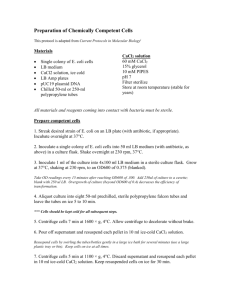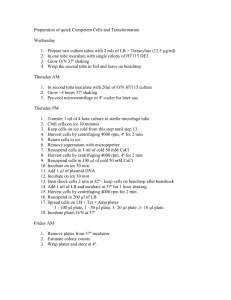E. coli Materials et al.
advertisement
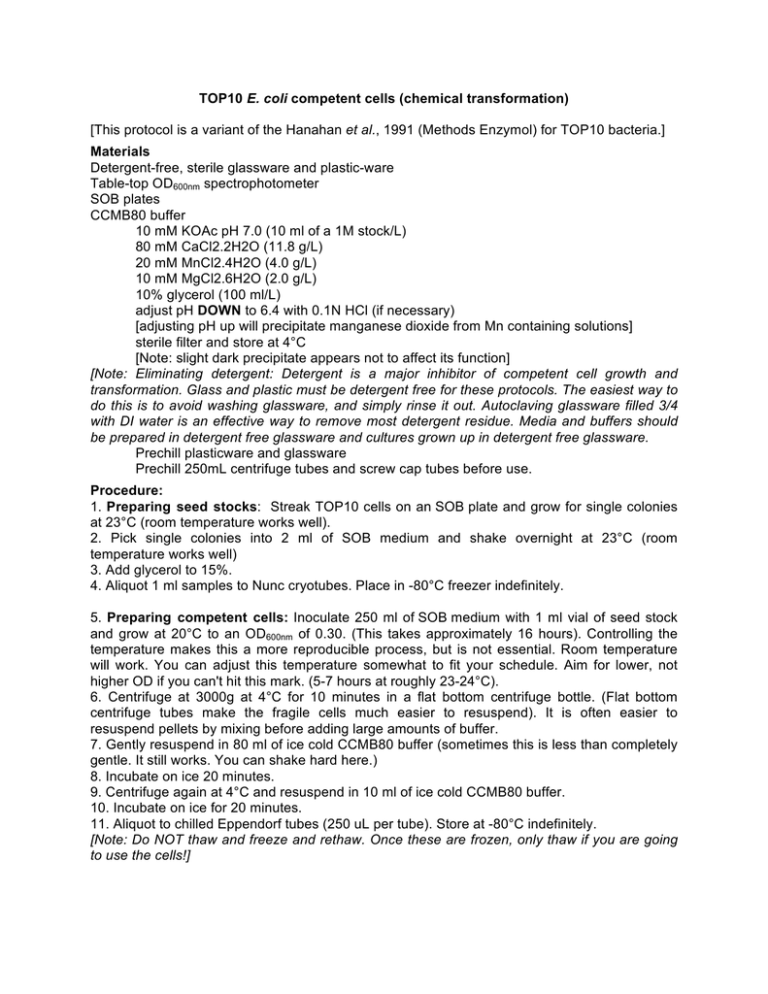
TOP10 E. coli competent cells (chemical transformation) [This protocol is a variant of the Hanahan et al., 1991 (Methods Enzymol) for TOP10 bacteria.] Materials Detergent-free, sterile glassware and plastic-ware Table-top OD600nm spectrophotometer SOB plates CCMB80 buffer 10 mM KOAc pH 7.0 (10 ml of a 1M stock/L) 80 mM CaCl2.2H2O (11.8 g/L) 20 mM MnCl2.4H2O (4.0 g/L) 10 mM MgCl2.6H2O (2.0 g/L) 10% glycerol (100 ml/L) adjust pH DOWN to 6.4 with 0.1N HCl (if necessary) [adjusting pH up will precipitate manganese dioxide from Mn containing solutions] sterile filter and store at 4°C [Note: slight dark precipitate appears not to affect its function] [Note: Eliminating detergent: Detergent is a major inhibitor of competent cell growth and transformation. Glass and plastic must be detergent free for these protocols. The easiest way to do this is to avoid washing glassware, and simply rinse it out. Autoclaving glassware filled 3/4 with DI water is an effective way to remove most detergent residue. Media and buffers should be prepared in detergent free glassware and cultures grown up in detergent free glassware. Prechill plasticware and glassware Prechill 250mL centrifuge tubes and screw cap tubes before use. Procedure: 1. Preparing seed stocks: Streak TOP10 cells on an SOB plate and grow for single colonies at 23°C (room temperature works well). 2. Pick single colonies into 2 ml of SOB medium and shake overnight at 23°C (room temperature works well) 3. Add glycerol to 15%. 4. Aliquot 1 ml samples to Nunc cryotubes. Place in -80°C freezer indefinitely. 5. Preparing competent cells: Inoculate 250 ml of SOB medium with 1 ml vial of seed stock and grow at 20°C to an OD600nm of 0.30. (This takes approximately 16 hours). Controlling the temperature makes this a more reproducible process, but is not essential. Room temperature will work. You can adjust this temperature somewhat to fit your schedule. Aim for lower, not higher OD if you can't hit this mark. (5-7 hours at roughly 23-24°C). 6. Centrifuge at 3000g at 4°C for 10 minutes in a flat bottom centrifuge bottle. (Flat bottom centrifuge tubes make the fragile cells much easier to resuspend). It is often easier to resuspend pellets by mixing before adding large amounts of buffer. 7. Gently resuspend in 80 ml of ice cold CCMB80 buffer (sometimes this is less than completely gentle. It still works. You can shake hard here.) 8. Incubate on ice 20 minutes. 9. Centrifuge again at 4°C and resuspend in 10 ml of ice cold CCMB80 buffer. 10. Incubate on ice for 20 minutes. 11. Aliquot to chilled Eppendorf tubes (250 uL per tube). Store at -80°C indefinitely. [Note: Do NOT thaw and freeze and rethaw. Once these are frozen, only thaw if you are going to use the cells!] 12. E. coli transformation: 1 tube of TOP10 competent bacteria is good for the following: (i) 23 ligations (use roughly 80-100 uL cells per ligation reaction and add 1/10 volume DNA), (ii) 510 standard vector transformations (use 1-2 uL of purified plasmid DNA per 25-50 uL of bacterial cells), (iii) 3-4 transformations of “yeast plasmid preps” (use 65 to 85 uL of cells and 1/10 volume of yeast plasmid DNA), (iv) 3-4 Dpn1-treated QC PCR reactions (use 60-85 uL of cells and only 2-3 uL of Dpn1-treated PCR reaction). 13. Remove TOP10 cells from -80°C freezer and place on ice for 10-15 minutes. 14. Once thawed, carefully pipette appropriate amount to a fresh Eppendorf tube (see Step 12 above for amounts) and keep on ice. Do NOT vortex cells. 15. Add appropriate amount of DNA (see Step 12) and gently swirl the pipette tip to “mix”. Do NOT vortex. You may “flick” the tube 2-3 times and place on ice. 16. Incubate on ice for 10 minutes. 17. Heat shock in a water bath for 40-45 seconds. 18. Place on ice for 2 minutes. 19. Add 250-500 uL of SOC media (or 2xLB media works well too). Do not mix, do not vortex. 20. Place on rotator at 37°C incubator for 1 hour. 21. Plate the appropriate amount of cells onto selective plates (LB+AMP or LB+KAN). Use a sterile glass spreader (ethanol, flame, dry) and the plate spinner to spread “for single colonies” regardless of the transformation type (Step 12). For standard plasmid transformations, 25-50 uL of the final SOC/LB solution with cells is sufficient (one may add this directly to the plate, or first dilute with sterile water to increase volume). For yeast plasmid prep transformations or ligations 50-100 uL is sufficient. For Dpn1-treated QC PCR reactions, 25-50 uL is sufficient. [Note: Use of the small 35x15mm plates may be useful once the appropriate amount of solution + cells is determined to get single colonies spread in a “pinwheel” pattern on the agar plates.] 22. Incubate agar plates for 18-30 hours (roughly 1 day) at 37°C incubator (upside down) to obtain single colonies. Do NOT incubate longer than 1 day at 37°C. If needed, store plates (with grown colonies) at 4°C in the fridge.
